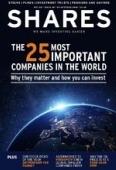Archived article
Please note that tax, investment, pension and ISA rules can change and the information and any views contained in this article may now be inaccurate.
Why the oil price is at a four-year high

The price of Brent crude oil is at its highest level in four years above $85 per barrel as traders react to impending US sanctions on major oil producer Iran and news of a breakthrough in trade talks between the US, Canada and Mexico.
WHAT IS HAPPENING WITH THE OIL PRICE?
In the last 12 months the black stuff has enjoyed a strong recovery and it is now at levels last seen in November 2014, around the time producers’ cartel OPEC turned a sell-off in the oil market into a fully-blown rout by failing to curb production.
Strong growth in the output from US shale created a supply glut and, led by Saudi Arabia, OPEC fought an ultimately unsuccessful battle for market share with these new shale producers before capitulating two years later in November 2016. The cartel teamed up with other major producer Russia and cut production for the first time in eight years.
WHAT IS FUELING THE RISE?
For the most part oil is now rising on supply issues, the concerted action by OPEC and Russia which helped to stabilise prices, and then a series of production issues for major producers like Venezuela and Nigeria contributed to its ascent.
Most seriously, Iran, thought to account for around 3% of global oil production, faces renewed sanctions from the US thanks to its deteriorating relationship with the Trump administration over its nuclear ambitions. This is expected to have a material impact on the world’s supply of oil when the sanctions take effect on 4 November.
As broker Cantor Fitzgerald observes: ‘Several major buyers in India and China have signaled that they will cut purchases of Iranian shipments, with China’s Sinopec saying it halved loadings from OPEC’s third largest producer in September.’
COULD PRICES HIT $100 PER BARREL?
Cantor notes the number of traders taking bets on prices hitting $90 is on the rise, so all eyes may soon be on $100 per barrel.
A key consideration is that Saudi Arabia, the only global producer thought to enjoy any spare capacity, may not have sufficient reserves to completely plug a growing supply gap.
If it fails to do so then oil could return to three figures for the first time since August 2014. This would provide a short-term boost to profit and cash flow at the likes of BP (BP.) and Royal Dutch Shell (RDSB).
WHAT ABOUT DEMAND?
Global trade tensions are already raising concerns over the health of the world economy and the increased transportation costs associated with $100 oil just adds to this negative picture. It could be that the best cure for high oil prices is demand falling in a weaker economic environment, although that may not be a positive backdrop for investors. (TS)
Important information:
These articles are provided by Shares magazine which is published by AJ Bell Media, a part of AJ Bell. Shares is not written by AJ Bell.
Shares is provided for your general information and use and is not a personal recommendation to invest. It is not intended to be relied upon by you in making or not making any investment decisions. The investments referred to in these articles will not be suitable for all investors. If in doubt please seek appropriate independent financial advice.
Investors acting on the information in these articles do so at their own risk and AJ Bell Media and its staff do not accept liability for losses suffered by investors as a result of their investment decisions.
Issue contents
Big News
- Aston Martin and Funding Circle endure shaky starts after floating on the stock market
- Housebuilders hit by foreign buyers’ tax plan
- Time to sell Royal Mail shares as the once-attractive dividend looks unsustainable
- Ocado, Just Eat, Rightmove and others selected for new reliable growth’ list
- What Shurgard’s €2.4bn IPO means for UK self-storage plays
- Airline sector still in the danger zone as cost and operational pressures intensify
 magazine
magazine









